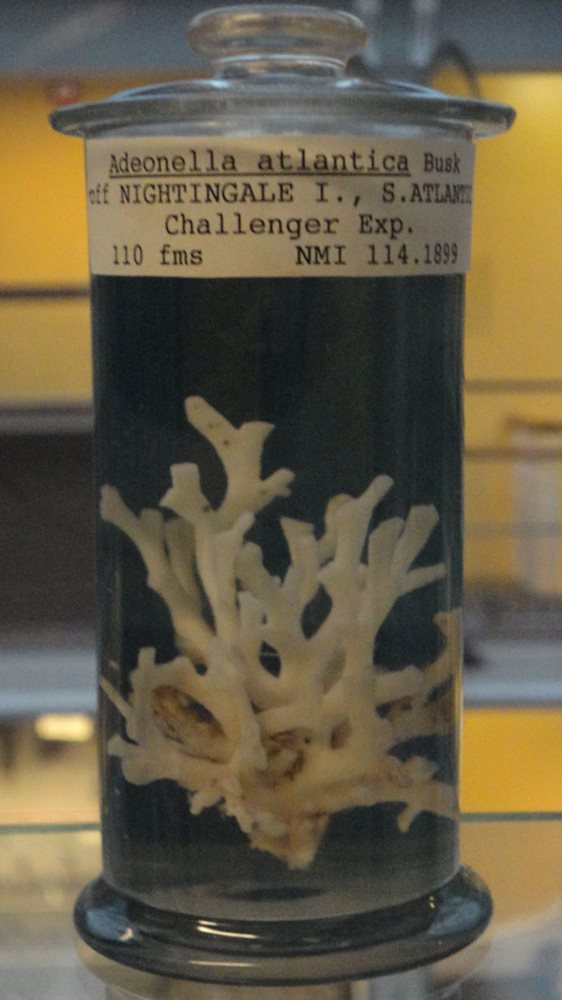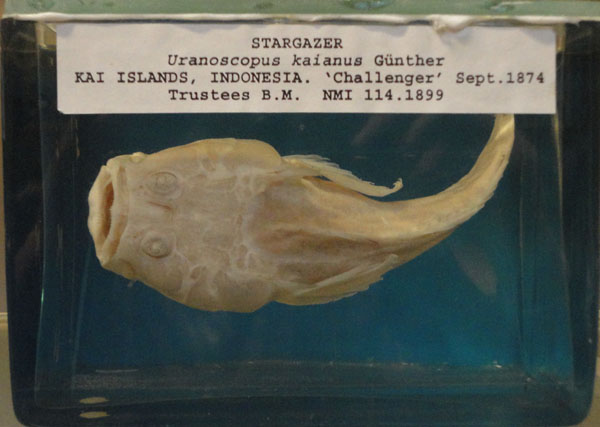Donated 1899
Eiseamail Z
Specimens collected during the voyage of HMS Challenger, an expedition often considered the origin of modern oceanography.
During the Inventory Project, about 1,000 zoological specimens collected during the Challenger Expedition were catalogued. They were received as a single donation from the British Museum, on the 8th of August 1899. They belong to a wide range of species, across several taxonomic groups.
The entry in the acquisition register states:
“1899.114; A collection of specimens from the Challenger Exp.; Given by the Trustees of the British Museum”
A scientific and commercial argument to study the ocean
The Challenger Expedition – named after the research vessel HMS Challenger - should be considered within a long tradition of British marine expeditions, alongside James Cook’s voyages or Charles Darwin’s travels on The Beagle.
By 1850, most of the world’s landmasses had been discovered. However, nothing was known of the nature of the deep sea. It was commonly accepted that this environment could be defined by darkness, high pressure and intense cold, and could not possibly support any form of life.
This position came into question following the publication of On the Origin of Species by Means of Natural Selection by Charles Darwin in 1859, which led to speculation that life in the deep ocean was possible.
Separately, the recent invention of the telegraph was putting pressure to connect continents with submarine, telegraphic cables. This necessitated investigations into the depth, shape, and general nature of the sea-floor: A strong commercial impetus for the study of the deep ocean emerged.
The Challenger Expedition and the origin of modern oceanography
The Challenger Expedition was therefore the first ever to be commissioned with the express purpose of studying the physics, chemistry, geology, and biology of the deep ocean.
HMS Challenger left Portsmouth in December 1872 and returned to Spithead, Hampshire in May 1876, spending over three years circumnavigating the globe and stopping at some 362 official stations. Numerous measurements were made and samples taken, including biological ones.
.jpg)
Fig. 2: Challenger specimen: Bryozoan colony from Nightingale Island (Tristan da Cunha)
The biological samples become museum specimens
On the expedition’s return, the biological samples were sent to the best international scientists available, accompanied with the following instructions:
“[…] be requested to select a complete set for the British Museum [the Natural History Museum, London use to be part of the British Museum] including all unique specimens and two specimens of all species of which there are more than three;
the remaining duplicates to be returned to [Sir Charles Wyville Thomson] for distribution with the sanction of their Lordships [the Treasury and the Trustees of the British Museum]”
Eventually, most Challenger specimens were deposited, as requested, in the British Museum. Amongst them were numerous “type specimens”: these are the specimens used to describe and name new species.
From the British Museum to the National Museum of Ireland
On the 24 June 1899, Ray Lankester, Director of the British Museum wrote to Dr Scharff (Keeper of the Natural History Division, National Museum of Ireland):
“The “Challenger” duplicates have hitherto been reserved for exchange against deep sea specimens required for our collection, but henceforth they are to be regarded as ordinary media of exchange.
It occurs to me that you might like to take this opportunity of improving your collections, and I should be glad to allow you to make selection from the “Challenger” duplicates on the condition that at the first opportunity you make us a suitable return.”
Staff from the National Museum of Ireland duly visited the British Museum to select specimens amongst the Challenger “duplicates”, unaware that some of these happened to be unmarked type specimens.
As a result, not only does the National Museum of Ireland hold a very large collection of historically important Challenger specimens, but a surprising amount of them are scientifically significant type specimens from the famous expedition.

Fig. 3: Stargazer from Indonesia, of a new species discovered during the Challenger Expedition
Where can I see the specimens?
Ninety-six fish and invertebrates from the Challenger Expedition are on display on the balconies of the Natural History Museum. Unfortunately, this area is currently closed to the public for safety reasons.
On the ground floor of the Museum, many of the specimens on display were collected during Irish expeditions of the same era of marine exploration.
Look for specimens from the Royal Irish Academy expeditions of 1885 and 1886 (on the Lord Bandon) or 1888 (on the Flying Falcon).
Find out more about the Challenger Expedition
Wheeler, A. & O’Riordan, C.E. 1969. Type Material of Fishes from the “Challenger” Expedition in the National Museum of Ireland. Proceedings of the Royal Irish Academy, vol. 68, section B, no.6.
The Challenger reports are available online at Report of the Scientific Results of the Voyage of HMS Challenger.
Location:
Eiseamail Z is located at:
In Storage
Previous artefact:
Next artefact:
